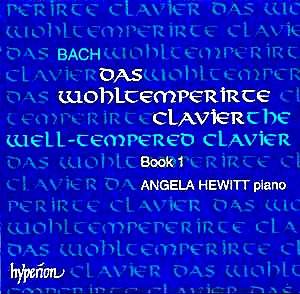 |
Johann Sebastian BACH (1685-1750) Crotchet
AmazonUK
AmazonUS |
Bach's Well-Tempered Clavier is a set of 24 preludes and fugues, in each major and minor key. Widely considered to be the summit of keyboard music, it is an encyclopaedia of forms and styles, and, especially, of contrapuntal composition. Angela Hewitt here continues her project to record all of Bach's keyboard works.
Hewitt plays the Well-Tempered Clavier in groups of four preludes and fugues; the first prelude being a sort of opening, and the last fugue being a sort of closing. This is an interesting idea, and one that might work well in concert, where it is almost ridiculous to perform the entire work in sequence. (Is it any more ridiculous to listen to it in this manner? It was undoubtedly not written to be performed in extenso.) But, this somewhat artificial separation leads to the perhaps over-interpretation of certain preludes and fugues to make them "fit" her ideal.
Hewitt makes the second fugue, in C minor, sing out with a delightful rhythm. This fugue sounds takes on a delightfully joyous tone in her interpretation. This same sound is heard in the E flat major prelude, and in many others, as Hewitt gives the music a great deal of liberty. She shines in these happy-sounding pieces; she seems to feel right at home in this Bach, that of the infinite possibilities inherent in music, and its power to bring peace and happiness to its listeners.
Yet, she seems a bit less in control in the slower, darker pieces. The long C sharp minor fugue is played here very slowly and softly, giving the piece a gloomy sound. Hewitt, in her notes, calls this "solemn introspection"; I cannot but feel that it is a bit too dark. This is a magnificent five-voice fugue, one of the most complex in Book I; while it is not one of the gayest pieces of the set, I feel it deserves a bit more than what Hewitt gives it here.
Not all of the slow pieces have such a sound, however. The E flat minor prelude, a sarabande full of emotion, is, as Hewitt says, "an impassioned aria of great eloquence". She certainly performs it as such, and it stands out as one of the best pieces of the recording. The following fugue is also played beautifully, with its slight staccato passages which clearly delimit each voice.
Rhythmically, Hewitt is not always in the right groove. For most of the pieces this is not a big problem, but I feel she flattens the syncopated rhythms of the F sharp major prelude, turning what is a beautifully composed two-part invention, driven by its syncopation, into a simple piece with no particularity. This is a shame; the rhythm of this prelude is magnificent, and it in one of the most beautiful preludes Bach composed.
She does have a fine control of dynamics in many cases. One example is the G minor prelude with its long trills, and subtle walking bass line. Hewitt is in perfect harmony with this type of playing, and this piece comes across as one of the finest on the recording.
A brief comment on Angela Hewitt's extensive liner notes - unlike most performers, she analyses and presents each prelude and fugue in her notes, which should be a model for all other recordings. One can learn more from these 15 pages than from most publications on the work. Notes like this are in all of her Bach recordings, and should be applauded.
While I am not overly enthusiastic, this is due, in part, to listening to this set as a group of individual pieces. When listened to as a whole, it sounds better than the sum of its parts. Hewitt presents the right overall atmosphere for this music, even if some of her choices don't work for me.
This is a very good recording, one of the best currently available on piano. While there are some lacunae, I feel that it is better as a whole than the sum of its parts.
Kirk McElhearn